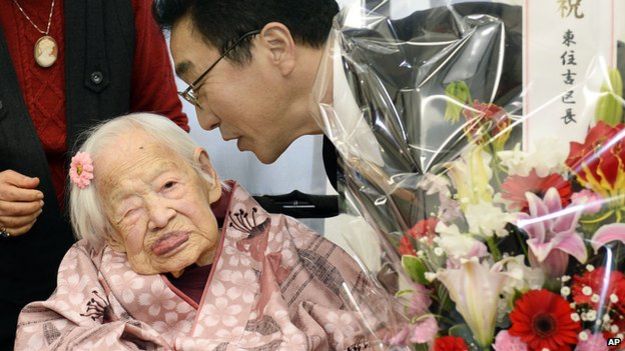She used to wear modern headscarves with colourful outfits. But the jihadists forced her to wear a long, black abaya, a cloak covering her body, and a niqab, a veil that covered all but the area around her eyes.
But Razan was no ordinary woman. She was a doctor at a hospital and a civil society activist who campaigned against violence, especially violence against women.
During the first two years of the uprising in Syria - before IS first appeared and started to seize northern and eastern parts of the country - Razan and her fellow activists were able to operate freely and press their demands for freedom and democracy.
"It was a golden time", she says. "We had big dreams."
But soon, those dreams turned into nightmares. Razan's public activities had to become secret and she was unable to meet male activists because of strict gender segregation.
Stonings
It got even worse when female jihadists, many of them foreigners, started to arrive in IS-held areas and monitored the activities of women like Razan.
"We used to do a lot of stuff hiding under our niqab because male jihadists would not uncover us," Razan says. "But when the Khansaa Brigade for female jihadists was formed, we were even afraid inside our own homes."
Members of the Khansaa Brigade had the power to remove women's veils, carry out surprise searches of their homes, and monitor what they were doing.
 The northern Syrian city of Raqqa is the de facto capital of the "caliphate" proclaimed by Islamic State
The northern Syrian city of Raqqa is the de facto capital of the "caliphate" proclaimed by Islamic StateGatherings for anything other than religious purposes were prohibited and those who attended illegal meetings risked punishment by the Khansaa Brigade.
Islamic State's treatment of civilians became more brutal after the group announced the creation of a "caliphate" in the territory under its control in Syria and neighbouring Iraq in June.
"Their violence was beyond description; they terrified people," Razan recalls.
"Public whipping for men and women became a common practice. There were several cases of stoning of women who were accused of adultery by the group."
Even wearing the wrong type of niqab - if it was not light enough or was striped, for example - could lead to a woman being punished. In many cases, Sharia courts got involved.
Bodies on road
One hot summer's morning in 2014, Razan herself incurred the wrath of IS.
When members of the group visited her hospital, they began questioning her and criticised the way in which she was wearing her niqab. Razan covered her face completely to avoid any trouble.
After the men had left, one of them came back and warned her: "Run for your life. They are going to bring you before a Sharia court."
"I owe him my life," Razan says. "I still don't know why he helped me but he saved my life."
 Women in IS-held areas of Syria are forced to wear long, black abayas and niqabs
Women in IS-held areas of Syria are forced to wear long, black abayas and niqabs"I left the hospital through a back door and I asked my father to pick me up. I was very worried that they would do something to me. I went to my sister's house. I never returned to my house again nor to the hospital."
A few days later, Razan's friends told her that IS members had been asking about her.
"I was afraid of being arrested, flogged or killed," Razan says.
Soon afterwards, she managed to flee the country by using another woman's ID. The drive to the Turkish border was a terrifying experience, she says.
"I still remember the beheaded bodies on the road.
"In the car there were two children who cried when they saw [them]", she adds. "The heads were lined up on both sides of the road. It was horrific."
'Bitter reality'
Razan was lucky to have a visa for the UK, where she is now living as a refugee.
 Razan's most treasured possessions are her house keys and stethoscope
Razan's most treasured possessions are her house keys and stethoscopeShe is safe there, but does not want to be identified out of fear for her relatives in Syria.
Razan says she is determined to pursue her dreams in seeking further education and to continue to support her civil society activists in Syria.
The reality is bitter for Razan and many of her generation who had high hopes of freedom and democracy in Syria.
"My dreams are different from the reality," she says. "The world is preoccupied with fighting IS and is ignoring the source of the problem - Bashar al-Assad."
Razan believes she will only return home once the president is no longer in power.
"I have the keys to my house in Syria. I am sure I will use them one day, hopefully very soon."

 Pesticides can block and mimic the function of human hormones
Pesticides can block and mimic the function of human hormones Some questioned whether BPA, found in babies' bottles, was that harmful
Some questioned whether BPA, found in babies' bottles, was that harmful The main concern over EDCs is how they affect early development
The main concern over EDCs is how they affect early development
 A miniature replica of the box used to promote a book about the escapade
A miniature replica of the box used to promote a book about the escapade The replica shows how straps were fixed inside the box
The replica shows how straps were fixed inside the box
 Reg Spiers in London before his freight journey in 1964
Reg Spiers in London before his freight journey in 1964 Hollywood royalty Ford has more films in the pipeline
Hollywood royalty Ford has more films in the pipeline The plane crashed just short of the Santa Monica Municipal Airport
The plane crashed just short of the Santa Monica Municipal Airport IS says ancient shrines and statues - like this Assyrian relief - are "false idols"
IS says ancient shrines and statues - like this Assyrian relief - are "false idols" Many of Nimrud's artefacts have been transferred to museums in Baghdad and overseas, but giant "lamassu" statues - winged bulls with human heads - remain on site
Many of Nimrud's artefacts have been transferred to museums in Baghdad and overseas, but giant "lamassu" statues - winged bulls with human heads - remain on site Nimrud lies just south-east of Mosul, where militants attacked artefacts with sledgehammers last week
Nimrud lies just south-east of Mosul, where militants attacked artefacts with sledgehammers last week
 Abid Naseer (seen here in 2010) was previously arrested in the UK over a bomb plot in Manchester
Abid Naseer (seen here in 2010) was previously arrested in the UK over a bomb plot in Manchester The trial heard from MI5 operatives dressed in wigs and make-up
The trial heard from MI5 operatives dressed in wigs and make-up IS-held areas of Tikrit have come under heavy bombardment since the offensive began
IS-held areas of Tikrit have come under heavy bombardment since the offensive began Soldiers and militiamen have recaptured several towns and villages surrounding Tikrit
Soldiers and militiamen have recaptured several towns and villages surrounding Tikrit

 Iranian-backed Shia militiamen have played a key role in forcing IS to retreat north of Baghdad
Iranian-backed Shia militiamen have played a key role in forcing IS to retreat north of Baghdad The car's body is armour-plated to enable a driver to make a quick getaway in the event of a shooting
The car's body is armour-plated to enable a driver to make a quick getaway in the event of a shooting The Prombron is believed to be the world's most expensive SUV
The Prombron is believed to be the world's most expensive SUV All the car's internal features, such as the steering wheel, are finished with a high level of detail
All the car's internal features, such as the steering wheel, are finished with a high level of detail The car windows are extra thick to protect passengers from any kind of attack
The car windows are extra thick to protect passengers from any kind of attack A Dartz car featured in the Sacha Baron Cohen film The Dictator
A Dartz car featured in the Sacha Baron Cohen film The Dictator
 A small honeycomb structure cloaked the cylinder beneath from being felt
A small honeycomb structure cloaked the cylinder beneath from being felt Prof Bertoldi has worked on metal 'metamaterials' to improve engine components
Prof Bertoldi has worked on metal 'metamaterials' to improve engine components The group's latest ceramic designs use a lattice of lattices, rather like the Eiffel Tower
The group's latest ceramic designs use a lattice of lattices, rather like the Eiffel Tower Becky Watts went missing from her family home on 19 February
Becky Watts went missing from her family home on 19 February Nathan Matthews and Shauna Hoare were arrested at the weekend
Nathan Matthews and Shauna Hoare were arrested at the weekend Floral tributes have been left outside Becky's home in St George, Bristol
Floral tributes have been left outside Becky's home in St George, Bristol The
The The jawbone was found close to the area where Lucy was discovered
The jawbone was found close to the area where Lucy was discovered
 A member of Mr Tsarnaev's defence team walks into the court Wednesday morning
A member of Mr Tsarnaev's defence team walks into the court Wednesday morning Many victims of the bombings attended the first day of the trial
Many victims of the bombings attended the first day of the trial The two bombs detonated at the finishing line of the Boston Marathon
The two bombs detonated at the finishing line of the Boston Marathon





